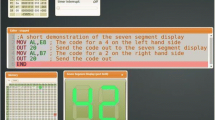Abstract
The challenges of effective teaching in mass education environments are well documented. The cohorts of large size generally means that identification of struggling students is usually only at a point when meaningful interventions are too late. This paper reports on the use of novel technologies to provide insights into areas of learner behaviour in large-scale computer programming modules. Accordingly, this paper brings together a previous series of investigative studies of student key engagement points during a typical programming module (1) seat position tracking during programming lectures, (2) Video Lecture Capture viewing behaviours and (3) Student Heart Rate monitoring during lectures. The paper combines the significant findings of each investigation to provide a variety of analysis using Machine Learning (ML) classification modeling. The purpose of the MC study is to create models that could identify students that are likely to pass and those that may be at risk of failing the module.
Access this chapter
Tax calculation will be finalised at checkout
Purchases are for personal use only
Similar content being viewed by others
References
The Returns to Higher Education Qualifications, London Economics (2011). https://assets.publishing.service.gov.uk/government/uploads/system/uploads/attachment_data/file/32419/11-973-returns-to-higher-education-qualifications.pdf
Shadbolt, J.: Shadbolt review of computer sciences degree accreditation and graduate employability (2017). https://dera.ioe.ac.uk/16232/2/ind-16-5-shadbolt-review-computer-science-graduate-employability_Redacted.pdf
Mulryan-Kyne, C.: Teaching large classes at college and university level: challenges and opportunities. J. Teach. High. Educ. 15(2), 175–185 (2010)
Bandiera, O., Larcinese, V.: The impact of class size on the performance of university students (2010). https://voxeu.org/article/impact-class-size-performance-university-students#fn
UK Performance Indicators: Non-Continuation Rates HESA (2017). https://www.hesa.ac.uk/news/07-03-2019/non-continuation-tables
McGowan, A, Hanna, P, Greer, D., Busch, J.: Learning to program – choose your lecture seat carefully? Paper Presented at Innovation and Technology in Computer Science Education, Bologna, Italy, 03–07 July 2017
McGowan, A, Hanna, P., Anderson, N.: Teaching programming: understanding lecture capture YouTube analytics. In: ITiCSE 2016 Proceedings of the 2016 ACM Conference on Innovation and Technology in Computer Science Education, pp. 35–40. ACM (2016)
McGowan, A., Hanna, P., Greer, D., Busch, J.: Lecturing to your students: is their heart in it? FTC 880, 1005–1016 (2018). https://doi.org/10.1007/978-3-030-02686-8_75
Jiawei, H., Micheline, K., Jian, P.: Data Mining: Concept and Techniques, 3rd edn. Elsevier, Amsterdam (2011)
Hall, M., Frank, E., Holmes, G., Witten, I.: The WEKA data mining software. ACM SIGKDD Explor. Newsl. 11(1), 10 (2009)
Longadge, R., Dongre, S.: Class imbalance problem in data mining review. 2(1) (2013). www.ijcsn.org. ISSN 2277-5420
Author information
Authors and Affiliations
Corresponding author
Editor information
Editors and Affiliations
Rights and permissions
Copyright information
© 2020 Springer Nature Switzerland AG
About this paper
Cite this paper
McGowan, A. et al. (2020). Use of Wearable Technologies with Machine Learning to Understand University Student Learning Behaviours to Predict Students at Risk of Failing. In: Ahram, T., Taiar, R., Colson, S., Choplin, A. (eds) Human Interaction and Emerging Technologies. IHIET 2019. Advances in Intelligent Systems and Computing, vol 1018. Springer, Cham. https://doi.org/10.1007/978-3-030-25629-6_50
Download citation
DOI: https://doi.org/10.1007/978-3-030-25629-6_50
Published:
Publisher Name: Springer, Cham
Print ISBN: 978-3-030-25628-9
Online ISBN: 978-3-030-25629-6
eBook Packages: EngineeringEngineering (R0)




